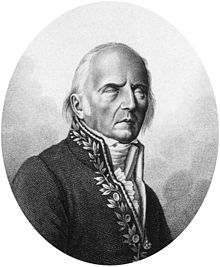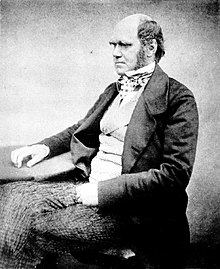Evolution theory
A theory of evolution is the scientific and coherent description of the formation and change in biological units, especially species , as a result of organismic evolution , i.e. H. a development process in the course of the earth's history that has taken place and continues. Theories of evolution are naturally a product of the time they were created and reflect the respective knowledge, the facts and the scientific approaches of the time.
Since modern evolutionary biology deals with numerous, sometimes very different approaches and analyzes, where temporary hypotheses are often designed and later given up again in favor of more refined hypotheses, there is now consensus that one should not speak of an actual and all-encompassing "theory of evolution", rather, there is a kind of theory building where many strands of knowledge from paleontology to molecular biology flow together and complement each other to form an overall view. An overview and further links about the central contents of the current theories are dealt with under Evolution , the currently discussed hypotheses and theories about the origin of life under Chemical Evolution .
Origin of the theories of evolution
Vague ideas about how or where life came about have been expressed on various occasions by scholars of ancient Greece. Thales von Milet assumed the origin of life in water, Anaximander spoke directly of a spontaneous generation in a damp environment, Aristotle suspected the spontaneous generation in mud and dirt. Judaism, Christianity and Islam were based on a divine act of creation and represented the concept of a constancy of species, which many scholars in Europe followed until the Enlightenment . All of these hypotheses seemed more or less convincing in their respective time and taking into account the state of knowledge at the time. However, they did not represent a theory. Only then did comprehensive scientific theories develop on the basis of empirical findings.
Jean-Baptiste de Lamarck (1744–1829) proposed a theory of species change in 1809 , making him one of the first evolution theorists. He assumed that acquired traits were inherited (he did not regard species as immutable), an approach that was widespread among naturalists for a long time in the 19th century - before knowledge of the fundamentals of genetics . Even Charles Darwin assumed 50 years later (1859) that acquired qualities could be passed on. Lamarck's theories are usually referred to as Lamarckism , although in practice the term is reduced to the aspect of inheritance of acquired traits. Another component of his theoretical structure is the fact that he assumed that small organisms would still be produced continuously today. He also assumed that each recent species has its own evolutionary line, that all species have developed from separate spontaneous generations.
As a comparative anatomist and founder of palaeontology, Georges Cuvier (1769–1832) came to the knowledge through the investigation of numerous fossils in various deposits that the blueprints of living things are related and that living things can become extinct. He attributed a central role to the recurring mass extinction, for example through marine transgressions , as he assumed at the time, and was therefore a main proponent of catastrophism .
Étienne Geoffroy Saint-Hilaire (1772–1844) opposed the theses of Cuvier and advocated a continuity of development from organisms known only to fossils to recently living organisms. He postulated a basic plan for all animals, invertebrates and vertebrates, and in this regard had widely noticed disputes (the Paris academy dispute of 1830) with Georges Cuvier, who assumed four different main building plan types (vertebrates, molluscs, radiant animals and arthropods) in the animal kingdom.
Charles Darwin (1809–1882) drafted his theory in 1838. His theories were based on broad biological and scientific observations, as far as they were known at the time. Because of the poorly open-minded environment in his home country, Darwin withheld his theory for 20 years; only after a younger zoologist, Alfred Russel Wallace (1823–1913) came to very similar conclusions, did Darwin decide in 1858 to publish it. Both works, which were soon referred to as Darwinism or Darwin's theory of evolution, emerged independently of one another. Differences in content related to the question of how intensively the various evolutionary factors affect each other and which ones are decisive. Both explained biological evolution through the better adaptation of all organisms to their environment and, associated with this, a gradual increase in complexity (higher development and structural plan transformations).
Further historical development
Darwin and Wallace presented their work on the theory of evolution through natural selection together at the Linnean Society of London in 1858 . This publication received little attention, but Darwin's book The Origin of Species , published in 1859, explained the system of theories in great detail and led to the expected social and ecclesiastical debate. Darwin's specific theses on evolution, such as gradualism and natural selection , met with considerable resistance. Lamarckists were also opponents, arguing that traits were acquired through training and not through a selection process . However, since all experiments to prove “Lamarckism” failed, this theory was finally dropped in favor of “Darwinism”. In the years that followed, Darwin's theory of evolution became increasingly accepted.
However, Darwin could not explain how traits are passed down from generation to generation and why variations on these traits did not mix by inheritance. The mechanism for this was only supplied by Gregor Mendel in 1865 (printed in 1866) , who showed that characteristics are often inherited in a precisely defined and predictable way. However, his work remained undiscovered until around 1900, when the hereditary bases were independently discovered, published and propagated by other scientists. However, different calculations and predictions regarding the speed of evolution resulted and led to a deep gap between the Mendelian and Darwinian concepts of inheritance, because the genetic findings now discovered suggested a constancy of the characteristics. The contradiction to the variability of species according to Darwin's theory of evolution was not resolved until 1930, u. a. through the work of statistician Ronald Fisher . The result was a combination of Darwin-Wallace's natural selection with Mendelian inheritance rules , which has been termed the Synthetic Theory of Evolution . Ernst Mayr u. a. expanded them to include findings from other areas of science, particularly population biology . The synthetic theory has been continuously completed since then, initially to include DNA as the carrier molecule of the genetic material by Oswald Avery in 1944. Almost a decade later, James Watson and Francis Crick explained the functionality and thus the physical structure by deciphering the molecular structure of DNA in 1953 Basis of inheritance. Among other things, this enabled an understanding of the mutation process, which is essential for evolution . Since then, genetics and molecular biology have been added as important central basic sciences.
Together, these and other building blocks and bases form the teaching and research content of today's modern evolutionary biology.
The Frankfurt theory of evolution provides an explanatory concept for a specific aspect of evolution , which has so far lacked broad international recognition because it occupies a position that is incompatible with the synthetic theory of evolution.
Knowledge and belief
Regardless of the scientifically coherent and increasingly substantiated theories of biological evolution, parts of the population doubt the reality of the biological evolution process and the theory of evolution. Protagonists of a frequently creationist way of argumentation are mostly religiously inspired groups, primarily from the fundamentalist area of the three Abrahamic religions Judaism , Christianity and Islam , whose strict followers literally interpret the often pictorial language of religious writings regarding the origin of the earth and living organisms. The corresponding written creation myths come from the first and second millennium BC, but suggest an even earlier oral origin, which at least goes back to the Sumerian - Akkadian period of ancient Mesopotamia . The transfer of the interpretations of that time into today's knowledge of the real world is to be assessed as unscientific.
Christian fundamentalism , as it is propagated in parts of the USA and spread from there to other regions of the world, is considered to be the influential origin of a renewed skepticism of evolutionary theory in the 20th and 21st centuries . In the currents of Islam , non-scientific ways of reasoning and a purely religiously based view of earthly living beings are generally widespread.
Most Christian churches in Europe recognize the scientific theory of evolution in principle and try to find a compromise , for example in theistic evolution . In a message from Pope John Paul II on October 22, 1996 , the Roman Catholic Church declared that the theory of evolution was compatible with the Christian faith. The Evangelical Church in Germany also distances itself from creationism.
See also
Web links
- Homepage of the AG EvoBio
- What are evolution theories? on YouTube (December 2011, 14:15 min.)
Individual evidence
- ^ Henry Fairfield Osborn : From the Greeks to Darwin: An Outline of the Development of the Evolution Idea . Macmillan and Co., London 1905.
- ↑ Wolfgang Schad (Hrsg.): Evolution as a principle of understanding in the cosmos, man and nature. Free Spiritual Life Publishing House, Stuttgart 2009, pages 223-251.
- ↑ Ulrich Kutschera : fact evolution. What Darwin couldn't know. Deutscher Taschenbuch Verlag, Munich 2009, pp. 291–292.
- ^ AR Wallace & C. Darwin (1858): On the Tendency of Species to form Varieties, and on the Perpetuation of Varieties and Species by Natural Means of Selection. Jour. of the Proc. of the Linnean Society (Zoology), 3, pp. 53-62. [1]
- ^ F. Weiling (1991): Historical study: Johann Gregor Mendel 1822-1884. At the. J. Med. Genet. 40: 1, pp. 1-25; Discussion p. 26.
- ^ Peter J. Bowler: The Mendelian Revolution: The Emergence of Hereditarian Concepts in Modern Science and Society. Johns Hopkins University Press, Baltimore 1989, ISBN 978-0-8018-3888-0 .
- ↑ Ulrich Kutschera & Karl J. Niklas (2004): The modern theory of biological evolution: an expanded synthesis. Natural Sciences, 91: 6, pp. 255-276.
- ↑ Ulrich Kutschera (2008): Evolutionary Biology. 3. Edition. Publishing house Eugen Ulmer, Stuttgart.
- ^ Pigliucci, Massimo & Müller Gerd B .: Evolution - the Extended Synthesis. MIT Press, Cambridge 2010.
- ^ Neil A. Campbell , Jane B. Reece : Biology. German translation, Ed. Jürgen Markl. Spektrum Akademischer Verlag, Heidelberg / Berlin 2003, pages 564-565.
- ↑ John Paul II .: Messagio di Giovanni Paolo II ai partecipanti alla plenaria della pontificia accademia delle scienze, 22.10.1996, vatican.va. Retrieved June 23, 2017 .
- ↑ 1996: John Paul II on the theory of evolution, forum- Grenzfragen.de. Retrieved June 23, 2017 .
- ↑ Evangelical Church draws a clear dividing line from creationism. On: ekd.de from April 1, 2008, accessed on July 10, 2018.


